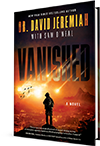From the January 2020 Issue

2020 Seeing Clearly
Where were you on New Year’s Eve, December 31, 1999? If you were like a lot of people all over the world, your New Year’s Eve celebrations were overshadowed by a looming fear that the world as we know it might come to an end a few seconds after the stroke of midnight.
Why? Because of the Y2K computer crisis. Remember that? On the eve of a new millennium, no one knew for sure what would happen when the clock struck midnight—but all assumed the calendars in computers around the world would go haywire.
It’s natural to wonder about the future, but our challenge is not to let wonder turn into worry.
When this error, and its potential implications, surfaced in the mid-1990s, it set off mad speculations and warnings about what would happen if computer software wasn’t fixed by January 1, 2000. The possibility was that computer systems all over the world—at military bases, utility companies, transportation hubs, and hospitals—would crash, go offline, and result in mass chaos.
Survivalist and conspiracy groups went into overtime, stockpiling food and water, disconnecting from utility power grids, buying up guns for self-protection, and forecasting apocalyptic scenarios. Many predicted that life as we knew it would grind to a screeching halt.
So what happened at 12:01 a.m. on January 1, 2000? Not much. Trains and planes continued to run, nuclear power plants didn’t melt down, and militaries around the world stayed in place. And the famous crystal ball in Times Square dropped right on schedule. Revelers around the world partied with a “Y2K? What Y2K?” attitude. Thankfully, computer experts had gone into hyperdrive mode for the last couple of years before the turn of the millennium and repaired the problem. There were scattered, minor disruptions here and there across the globe, but nothing to match the doomsday scenarios that had been forecast.
The year 2000 is the only turn-of-the-millennium that any of us living today will experience. It was a unique moment in human history, made all the more memorable by the Y2K scare. But we have a notable turning coming at the beginning of this month: the beginning of a new year and decade! While we don’t have a giant computer bug to make us uneasy, there are plenty of things happening in the world to make us wonder what the year 2020 will bring.
How are you feeling about the coming year, the beginning of a new decade? What are you forecasting for yourself, your family, your nation, and our world? It’s natural to wonder about the future, but our challenge is not to let wonder turn into worry. We need a way to keep the present and the future in clear, biblical focus so that no matter what 2020 brings, our hope will be in the God of the past, present, and future. And that’s the purpose of this month’s issue of Turning Points—to tweak the biblical lenses through which we view the world as we look ahead to the new year.
When you visit the optometrist to have your vision checked, the doctor will have you view letters and numbers through a variety of test lenses: “Is this one sharper or this one? How about now? Is this lens or the previous one the most clear? Good—now the same thing again for the other eye. This lens or this one?”
You know the drill, right? The goal is to find the lens that gives you the clearest, sharpest, most faithful representation of what you are seeing. And that’s what the Bible does for us. It helps us see the world and all its circumstances from God’s point of view. And our vision can’t get much clearer or sharper than that!
Have fun looking ahead; here’s to a faithful and focused 2020!
More Articles
This Month's Magazine Resource

Vanished
Based on Dr. Jeremiah's extensive research on Bible prophecy, this novel puts you right in the middle of the action, following military leader John "Haggs" Haggerty as he navigates a world on the brink of the Rapture.
Subscribe Now
Each month, read articles and devotionals from Dr. David Jeremiah that will encourage, challenge, and strengthen your walk with the Lord.














 Turning Point for God is a tax-exempt, not-for-profit, religious corporation as defined under Section 501(c)(3) of the Internal Revenue Code. Your donation gift(s) are very much appreciated and may qualify as a charitable deduction for federal income tax purposes.
Turning Point for God is a tax-exempt, not-for-profit, religious corporation as defined under Section 501(c)(3) of the Internal Revenue Code. Your donation gift(s) are very much appreciated and may qualify as a charitable deduction for federal income tax purposes.




